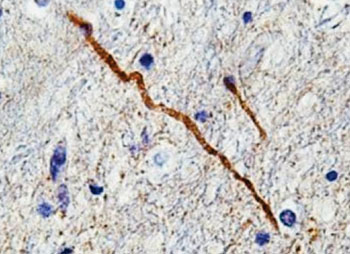Protein Biomarker Identifies Damaged Brain Wiring After Concussion
By LabMedica International staff writers
Posted on 08 Dec 2015
Mild traumatic brain injury (TBI) or concussion is often defined as a brief loss of normal brain function typically following a blow to the head and is by far the most common form of TBI and frequently does not even receive medical attention.Posted on 08 Dec 2015
A brain protein called alpha II-spectrin N-terminal fragment (SNTF), which rises in the blood after some concussions, signals the type of brain damage that is thought to be the source of cognitive impairments, and may be useful as a biomarker of permanent axonal injury.

Image: SNTF stained axons (brown) shortly after traumatic brain injury. The undulating course suggests damage to the internal skeleton, and the SNTF stain shows the high calcium concentration-activated enzymes that destroy the axon from the inside out (Photo courtesy of the laboratory of Douglas Smith, MD).
Scientists at University of Pennsylvania School of Medicine (Philadelphia, PA, USA) selected TBI cases to include 18 patients who died acutely following severe TBI, with survival times ranging from six hours to one week. Detailed reports from the diagnostic autopsy and/or forensic reports were available for all cases and indicated a history of a single severe TBI, supported by autopsy findings. TBI cases were compared to material from 16 age/sex-matched controls, acquired at routine diagnostic post-mortem at the same institution. Controls had no documented history of TBI.
Paraffin-embedded tissue from human postmortem studies was subjected to routine histology including hematoxylin and eosin (H&E) staining as well as immunohistological techniques. A synthetic peptide corresponding to the calpain-generated neoepitope in SNTF (CAQQEVY) was conjugated covalently to maleimide-activated Sepharose via the cysteine side chain and the resulting resin used for affinity purification of SNTF-specific antibodies. Adjacent, serial sections were labeled with an antibody reactive for the N-terminal amino acids 66–81 of the amyloid precursor protein (APP). Some sections were coverslipped using fluorescence mounting medium and visualized using a confocal Eclipse Ti microscope (Nikon; Tokyo, Japan).
Immunohistochemistry (IHC) specific for SNTF was compared to that of amyloid precursor protein (APP), the current standard for diffuse axonal injury (DAI) diagnosis, and other known markers of axonal pathology including non-phosphorylated neurofilament-H (SMI-32), neurofilament-68 (NF-68) and compacted neurofilament-medium (RMO-14) using double and triple immunofluorescent labeling. Supporting its use as a biomarker of DAI, SNTF immunoreactive axons were observed at all time points following both human severe TBI and in the model of mild TBI.
Robert Siman, PhD, a coauthor of the study, said, “The study suggests that we may soon have a blood biomarker for concussion akin to the standard blood test used to detect cardiac damage from heart attacks. SNTF in the blood of a concussed individual may provide a specific diagnosis of diffuse axonal injury as well as the process of axonal degeneration. The study was published on November 20, 2015, in the journal Acta Neuropathologica.
Related Links:
University of Pennsylvania School of Medicine
Nikon




 assay.jpg)









